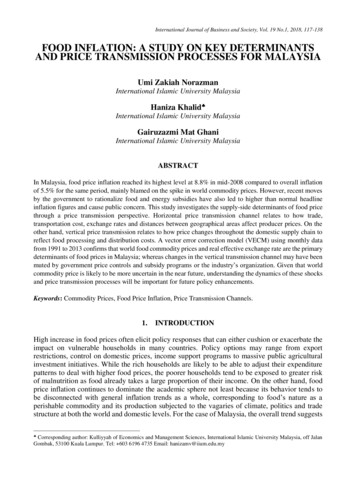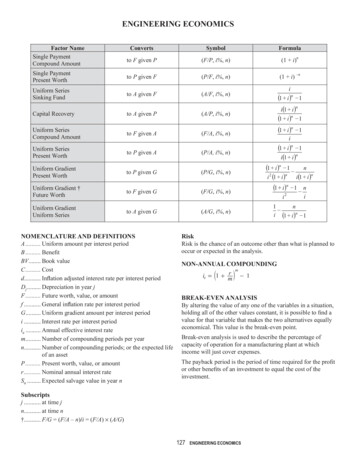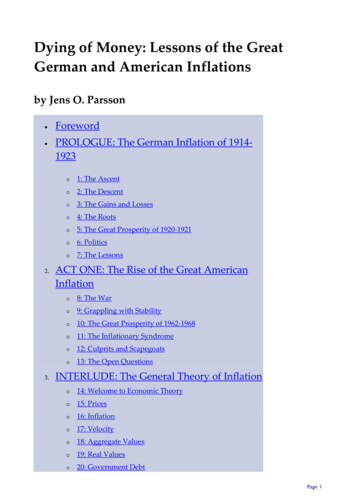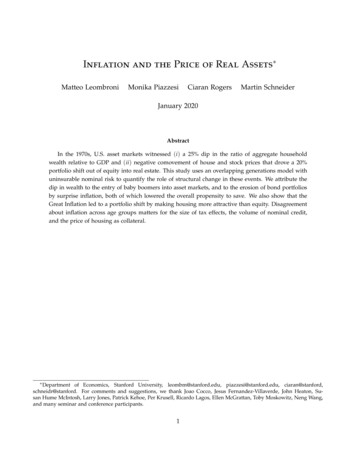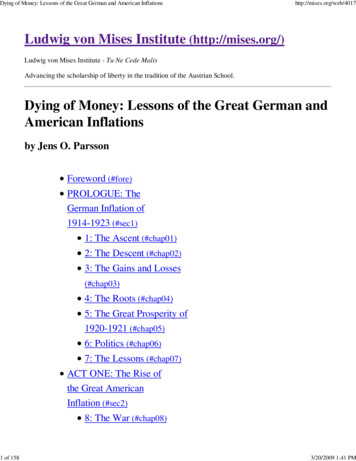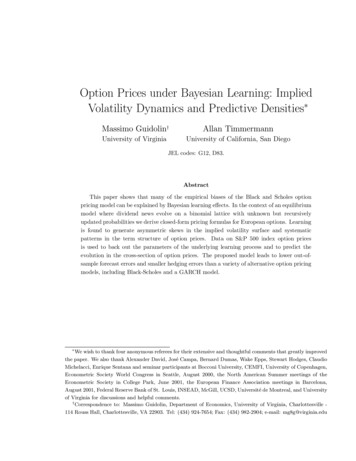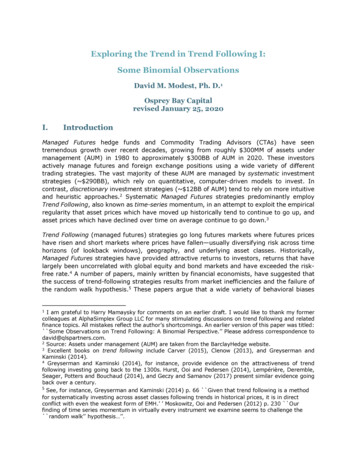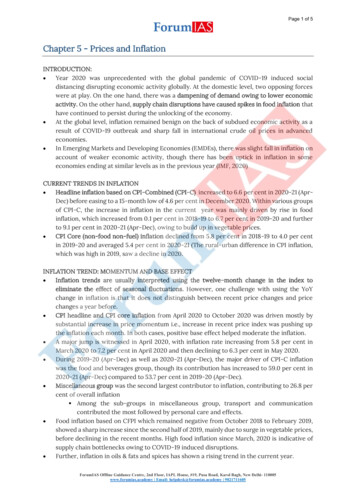
Transcription
Page 1 of 5Chapter 5 - Prices and InflationINTRODUCTION: Year 2020 was unprecedented with the global pandemic of COVID-19 induced socialdistancing disrupting economic activity globally. At the domestic level, two opposing forceswere at play. On the one hand, there was a dampening of demand owing to lower economicactivity. On the other hand, supply chain disruptions have caused spikes in food inflation thathave continued to persist during the unlocking of the economy. At the global level, inflation remained benign on the back of subdued economic activity as aresult of COVID-19 outbreak and sharp fall in international crude oil prices in advancedeconomies. In Emerging Markets and Developing Economies (EMDEs), there was slight fall in inflation onaccount of weaker economic activity, though there has been uptick in inflation in someeconomies ending at similar levels as in the previous year (IMF, 2020)CURRENT TRENDS IN INFLATION Headline inflation based on CPI-Combined (CPI-C) increased to 6.6 per cent in 2020-21 (AprDec) before easing to a 15-month low of 4.6 per cent in December 2020. Within various groupsof CPI-C, the increase in inflation in the current year was mainly driven by rise in foodinflation, which increased from 0.1 per cent in 2018-19 to 6.7 per cent in 2019-20 and furtherto 9.1 per cent in 2020-21 (Apr-Dec), owing to build up in vegetable prices. CPI Core (non-food non-fuel) inflation declined from 5.8 per cent in 2018-19 to 4.0 per centin 2019-20 and averaged 5.4 per cent in 2020-21 (The rural-urban difference in CPI inflation,which was high in 2019, saw a decline in 2020.INFLATION TREND: MOMENTUM AND BASE EFFECT Inflation trends are usually interpreted using the twelve-month change in the index toeliminate the effect of seasonal fluctuations. However, one challenge with using the YoYchange in inflation is that it does not distinguish between recent price changes and pricechanges a year before. CPI headline and CPI core inflation from April 2020 to October 2020 was driven mostly bysubstantial increase in price momentum i.e., increase in recent price index was pushing upthe inflation each month. In both cases, positive base effect helped moderate the inflation. A major jump is witnessed in April 2020, with inflation rate increasing from 5.8 per cent inMarch 2020 to 7.2 per cent in April 2020 and then declining to 6.3 per cent in May 2020. During 2019-20 (Apr-Dec) as well as 2020-21 (Apr-Dec), the major driver of CPI-C inflationwas the food and beverages group, though its contribution has increased to 59.0 per cent in2020-21 (Apr-Dec) compared to 53.7 per cent in 2019-20 (Apr-Dec). Miscellaneous group was the second largest contributor to inflation, contributing to 26.8 percent of overall inflation Among the sub-groups in miscellaneous group, transport and communicationcontributed the most followed by personal care and effects. Food inflation based on CFPI which remained negative from October 2018 to February 2019,showed a sharp increase since the second half of 2019, mainly due to surge in vegetable prices,before declining in the recent months. High food inflation since March, 2020 is indicative ofsupply chain bottlenecks owing to COVID-19 induced disruptions. Further, inflation in oils & fats and spices has shown a rising trend in the current year.ForumIAS Offline Guidance Centre, 2nd Floor, IAPL House, #19, Pusa Road, Karol Bagh, New Delhi- 110005www.forumias.academy Email: helpdesk@forumias.academy 9821711605
Page 2 of 5 Imports can add to the availability of any commodity and thus moderate prices in case ofshortfalls in domestic supply. In the case of pulses, it is seen that import is highly negativelycorrelated with production.CPI inflation in oils and fats has been increasing since August 2019 and has reached 20 percent in December 2020. While inflation in mustard oil, groundnut oil and refined oil(sunflower, soyabean etc.) is above 20 per cent, coconut oil is above 10 per cent in December2020. India is the largest importer of edible oils. Demand for edible oils is rising in India, while domestic production is almost stagnant,due to which dependence on imports has increased over the years.Escalation in wholesale prices was also witnessed after the COVID-19 induced restrictionspossibly because of labour shortages on account of reverse migration, social distancing infactories, and other transaction costs in the production and distribution network.INFLATION IN STATES CPI-C inflation increased in most of the states in the current year. However, regional variationpersists. Inflation ranged between 3.2 per cent to 11 per cent across States/UTs in 2020-21(Jun-Dec) compared to - 0.3 per cent to 7.6 per cent in the same period last year. In 17 States/UTs, overall inflation is below the all-India average in the current year with Delhihaving the lowest inflation, followed by Dadra & Nagar Haveli.Core inflation and headline infaltion: Which one relfected economic activity better IN 2020-21? For the period April 2020 to November 2020, CPI-C is weakly related to IIP growth while WPIinflation and CPI-C Core inflation are positively and strongly related to IIP growth. Therefore, core CPI-C inflation and WPI Inflation, have been more in sync with the demandconditions in the economy. A tight monetary policy may have a role in managing inflation in case of excess demand drivinghigh inflation. However, the current scenario presents a different picture. The current spike in CPI inflationdriven by spike in food prices is mainly a supply-side phenomenon. This can be easily assessedfrom the fact that arrivals in the market, for agricultural commodities like onion, tomato andpotato that have witnessed spikes in recent times, have been much lower compared to theprevious yearsCor inflation or Headline inflation: As a target for monetary policy Core inflation (inflation in the price index excluding food, fuel and other volatilecomponents) has been viewed by many as the better measure of inflation for monetarypolicy purposes. However, in the case of developing economies there are two deviations from theseassumptions: 1) inability of agents to smooth their lifetime consumption, and 2) otherstructural differences such as a high share of food in household consumption expenditurecontend that while under complete markets, the choice of targeting strict core inflation isthe best policy, with incomplete markets, headline inflation targeting is welfare improvingrelative to core inflation targeting.ForumIAS Offline Guidance Centre, 2nd Floor, IAPL House, #19, Pusa Road, Karol Bagh, New Delhi- 110005www.forumias.academy Email: helpdesk@forumias.academy 9821711605
Page 3 of 5INFLATION EXPECTATIONS The one year ahead inflation expectation for CPI-C inflation has risen during the current year.One year ahead inflation expectations for CPI-C inflation slightly rose from 4.0 per cent inFebruary 2020 to 4.4 per cent in October 2020. Inflation expectations survey of households conducted by RBI also pointed to a slight rise ininflation expectations from 9.1 per cent in March 2020 to 9.7 per cent in November 2020,though it was lower compared to September 2020.Global commodity prices The YoY growth in global commodity prices, except prices of precious metals and fertilizers,saw a decline from their levels in December 2019, between January and April 2020 owing toCOVID-19 induced restrictions around the world and consequent fall in demand for thesecommodities after remaining subdued during 2019. The largest impact of COVID-19 has been on energy prices driven by fall in crude oil prices.Energy prices have seen some rebound since the pandemic owing to production cuts byOPEC countries (World Bank, 2020), though they continue to be below levels of the previousyear. Agricultural prices remained more or less stable during the period of pandemic inducedrestrictions.REGULATION OF DRUG PRICES National Pharmaceutical Pricing Authority (NPPA), which is an independent regulator forpricing of drugs and to ensure availability and accessibility of medicines at affordable prices,has played an active role in addressing the exigencies arising out of COVID-19 pandemic andundertook necessary measures to ensure continued availability of life saving essentialmedicines throughout the country. It invoked extraordinary powers in public interest to ensure that policy enhances access tolife saving drugs like Heparin and Medical Oxygen. NPPA has revised upward the ceiling price of Heparin, a Scheduled Drug, included in thecovid-19 Treatment Protocol for a period of six months to ensure its continued availabilityduring the pandemic. NPPA also invoked extraordinary powers in public interest under Drug Price control Order,2013 and National Disaster Management Act to cap the price of Liquid Medical Oxygen (LMO)and the Oxygen Inhalation (Medicinal gas) for six months. Timely intervention by NPPA eased the situation of Medical Oxygen availability throughoutthe country, especially in distant and far-flung areas. In order to ensure availability of N95 mask at affordable prices in the country, NPPA, directedManufacturers/ Importers/Suppliers of N95 mask to maintain parity in prices for nongovernment procurements and to make available the same at reasonable prices. During the pandemic period, the government constituted an Inter-Ministerial EmpoweredCommittee to make recommendation for the export of drugs/items requested by foreigngovernments especially drugs like Hydroxychloroquine (HCQ) and Paracetamol.MEASURES TO CONTROL INFLATION The Government reviews the price situation regularly and has taken number of measuresfrom time to time to stabilize prices of food items. In the wake of rising prices of pulses, onionand potato, the Government has taken several steps to improve the availability of thesecommodities and make them available to consumers at affordable prices. These include:ForumIAS Offline Guidance Centre, 2nd Floor, IAPL House, #19, Pusa Road, Karol Bagh, New Delhi- 110005www.forumias.academy Email: helpdesk@forumias.academy 9821711605
Page 4 of 5 Banning the export of onion, Imposition of stock limit on onion Easing of restrictions on imports, facilitating imports at integrated check-posts,issuance of licenses for imports and reduction in import duties. Price Stabilization Fund (PSF) Scheme is being efficiently implemented and hassucceeded in achieving its objective of stabilizing prices of pulses and offeredsignificant benefits to all stakeholders.Government has taken a decision that all Ministries/Department having schemes withnutrition component or providing food/ catering/hospitality services would utilize pulsesfrom the central buffer. Pulses from the buffer are utilised for PDS distribution, in Mid-dayMeal Scheme and in ICDS Scheme.Creation of buffer stock of pulses has helped in moderating pulses prices. Lower prices ofpulses lead to consumer savings. Built buffer also led to remunerative prices to farmers asprocurement for buffer was undertaken at MSP or higher rates from them. States/UTs arealso being encouraged to set up their own State level PSF.Government of India maintains buffer stocks of onion under PSF for making appropriate pricestabilizing market interventions. Onion from buffer stock is released in a calibrated mannerthrough retail intervention to retail agencies/State/UTs and open market sale during leanseason/period to contain prices and availability.Onion Prices spikes Over the years, it has been observed that in the period August-November prices of onionsky-rocket.Why Price Spikes in August to November? Rabi harvesting takes place between March and May in most states and the crop is soldduring June-July period, kharif harvesting takes place between October and Novemberand the crop is available in the market till rabi harvest. The period between the two that is August to November is when we observe the prices ofonion rise sharply.Recent policy measures by government: Government has ensured that various pro-active measures are taken to curtail onion pricerise.In 2020, stock limit on the onions was imposed under the Essential Commodities(Amendment) Act 2020. In order to moderate the price rise, the government took a pre-emptive step byannouncing a ban on onion export so as to ensure availability to domestic consumers atreasonable rates, before the expected arrival of Kharif onion. Further, Onions are also being disposed off through Open Market Sales. The governmenthas also facilitated the import by the private traders, it has also been decided that MMTCwould import red onions to meet the demand supply gap.Suggestions There should be a transparent online platform where all information relating torequirement details by states, procurement undertaken state wise and month wise,amount disbursed state wise, agency wise, month wise should be made available for betterplanning and decision making. In Maharashtra, Gujarat, Haryana, Madhya Pradesh and Western Uttar Pradesh large scaleForumIAS Offline Guidance Centre, 2nd Floor, IAPL House, #19, Pusa Road, Karol Bagh, New Delhi- 110005www.forumias.academy Email: helpdesk@forumias.academy 9821711605
Page 5 of 5 storage of onions is taken in conventionally-designed structures.Develop an eVIN like tracking system: eVIN (electronic vaccine intelligence network) aimsto strengthen the evidence base for improved policy-making in vaccine delivery,procurement and planning for new antigens in India. For onion supply we do not needsuch a complicated system but a simple tracking system based on the principles of eVINmight be adequate.Conclusion During 2020-21, retail and wholesale inflation saw movements in the opposite directions. While headline CPI-C inflation saw an increase compared to the previous year, WPI inflationremained benign. Supply-side shocks especially owing to COVID-19 pandemic affected the retail inflation withfood articles contributing to the overall rise in inflation. The easing of supply side restrictions,which saw inflation moderate in December 2020 are expected to continue this easing. Government interventions to augment the supply of commodities as well as to ensure theprovision of essentials have likely softened the impact of the pandemic. Food inflation hasalready eased in December reducing overall inflationary pressures. Going forward, as food inflation eases further, overall inflation is expected to moderatefurther. On the other hand, improving demand conditions are likely to keep WPI inflation inthe positive territory with improving pricing power for manufacturers.ForumIAS Offline Guidance Centre, 2nd Floor, IAPL House, #19, Pusa Road, Karol Bagh, New Delhi- 110005www.forumias.academy Email: helpdesk@forumias.academy 9821711605
For the period April 2020 to November 2020, CPI-C is weakly related to IIP growth while WPI inflation and CPI-C Core inflation are positively and strongly related to IIP growth. Therefore, core CPI-C inflation and WPI Inflation, have been more in sync with the demand conditions in the economy.


